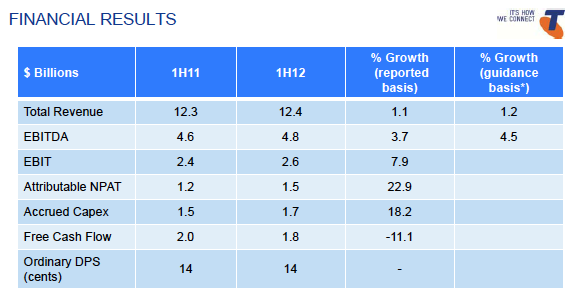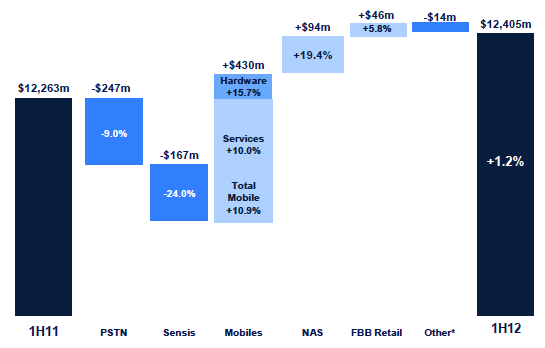Telstra (TLS) have announced their half year results to the market today, which immediately sold off the stock, down some 2% after lunch, although most of this could be contributed to the higher than expected Chinese CPI figures, since the underlying performance was in line with expectations.
Past the financial minutiae, the question is can Telstra be profitable (and maintain that lovingly high dividend) in a post-NBN (National Broadband Network) environment?
First, lets look at the headline numbers:

Revenue was only up marginally, around 1%, earnings (before interest and tax) were up 7.9% to $2.6 billion which translated to $1.5 billion in net profit, a rise of nearly 23% on the last period. Notably, free cashflow slipped some 11% to below $2 billion and the dividend remains the same at 14 cents for the half period, having been stuck at this level since 2006. The results were broadly in line with consensus expectations.
Telstra confirmed the guidance numbers for the full year, with total revenue and earnings expected to be “low single digit growth”. The real expectation for investors was a tacit confirmation that the 28 cents fully franked dividend is still intact.
The sales revenue chart below shows the transition amongst Telstra’s core offerings, with a continuing decline in fixed line and the deterioration of the Sensis directory business. This near half billion decline was picked up and exceeded by the growth in mobile phones business (although average revenue declining softly possibly reflecting savings by consumers) and increasing its mobile broadband customer base by nearly 500,000 with revenue increasing by 9 percent.

This is a welcome trend, one helped by Telstra’s decision to go “full mobile” given the NBN Co’s future dominance in the fixed line space, and allows for what should be a blue sky increase in Telstra’s customer service, which in recent years could not get any lower.
The Federal Government and NBN will pay Telstra $11 billion in exchange for the company to decommission its copper and cable networks, thus transferring fixed line customers to the NBN Co. Two questions come out of this payment: the first I highlighted above – can Telstra reinvent itself as a modern, customer service focused mobile-based business moving away from its historical infrastructure model? Secondly, what’s it going to do with the money?
This is not a business renowned for creating captial, although it gives a good return on the capital (over 30% per annum), equity per share (or book value) of the business has remained at around $1 per share since 2006. Under its last CEO Sol Trujillo, approx. $28 billion in shareholder capital was destroyed during his tenure. Further, the high amount of debt inflates this return, as actual return on funds employed is at a marginal 15%, although this is improving under current CEO David Thodey tenure.
The rise in Telstra’s share price (embarassingly, after The Future Fund sold off the majority of its stake, or was that the cause?) has effectively been about the speculation behind this payment. The company has committed to keep its solid, but stagnant dividend until FY2014, and most analysts expect a share buyback (thus returning capital to shareholders).
This method has been advocated, instead of a franked special dividend, due to the large amount of foreign shareholders on the books who will miss out on any franking. It also reduces the shares on issue and makes future payment of dividends cheaper, giving Telstra a cashflow edge as it transitions to a service based company. Going on past history, Telstra needs all the spare ammunition it can get and may find wandering around in a post-monopolistic wonderland a bit difficult.
